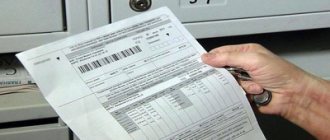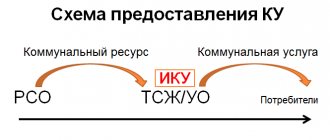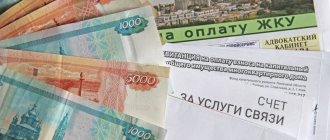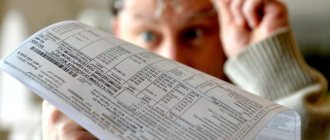What is included in utility bills
Housing and communal services provide for providing comfortable living conditions for citizens in apartment and private buildings. This process is controlled by management companies (MCs), which enter into contracts for the supply of necessary resources.
Before talking about calculating utility bills, you need to consider what is included in their list:
- water supply and sanitation;
- gas;
- electricity;
- heating the room.
Additionally, you need to study payments for the maintenance of the property, maintenance of the intercom, elevator, concierge, major repairs - all this is also included in the payment for housing and communal services.
Note! The management company is responsible for supplying and providing residents with the necessary resources; accordingly, the residents themselves must only promptly pay fees for the above services.
The management company is responsible for calculating payments for utility services.
It is also necessary to understand that common utilities (gas, water, electricity and heating) are provided in all houses, but additional services may vary. For example, not all apartment buildings have a concierge or intercom, which requires a service fee.
Errors and solutions
Example 1
Error: when calculating the heating fee, the owner substituted into the formula not the total area of the apartment he occupied, but the living area.
Result: An incorrect formula was created. 42 square meters (living area of the apartment) × 0.02 Gcal (standard) × 1500 rubles (tariff) = 1260 rubles.
Correctly: during all calculations, you should indicate the area , including built-in wardrobes, storage rooms and corridors. The formula should look like this: 55 sq. m (total living area) × 0.02 Gcal × 1500 rubles = 1650 rubles.
Example 2
Error: when taking readings from water meters, the owner indicated all the numbers shown on the meter.
Result: the formula for calculation looked like this: 10 thousand liters (readings) × 20 (tariff) = 200 thousand rubles. This is exactly how much, according to his calculations, he had to pay for water this month.
Correctly: the volume of water consumed is measured not in liters, but in cubic meters. When taking readings from metering devices, only 5 digits from the meter are taken into account. The formula should look like this: 10 cubic meters (readings) × 20 (tariff) = 200 rubles.
There is a lot of other materials about housing and communal services on our website. Read about housing and communal services reforms and the official fund, about free housing and communal services, what a concession is, and also about the responsibilities of an emergency dispatcher, a foreman, a plumber and a chief engineer in housing and communal services.
Types of payments
The payment document reflecting the list of paid services is a receipt, which is sent to the homeowner on a monthly basis. However, a detailed calculation of housing and communal services payments is not included in this document. It only indicates the types of services, indicating consumption rates and meter readings. Before paying, you need to clarify whether the invoice is correct.
Speaking directly about the general receipt for payment of utilities, it is necessary to indicate what types of payments should be included in the document in question:
- tariffs for water supply and sewerage, latest meter readings, or average cost per month;
- heating (in some houses it is calculated only during the heating season and is based on tariff indicators, and in some all year round in a single set amount);
- gas supply and maintenance, which also assumes an average indicator, or the results of reading the meter;
- electricity, which is reflected in the form of kW indicators per month;
- major repairs;
- maintenance of common property.
If additional services are available, the management company will also issue invoices for payment according to the tariffs.
Note! The receipt must contain information about the payer, the square footage of the premises and the personal account number. In addition, it is necessary to indicate tariffs and background information, otherwise the payment document cannot be considered correct.
Separate mention should be made about each type of payment, since they have their own characteristics of calculating payment and establishing average consumption indicators and tariffs.
For housing services
This category includes payments related to the maintenance of common property. There are no counter indicators provided here. The management company sets tariffs for intercom maintenance, cleaning, property maintenance, garbage removal, and so on. In this case, the cost should be determined according to the standards established by the region.
The cost of housing services is also confirmed by contracts with such suppliers. For example, the management of solid waste, that is, garbage removal, is provided by the relevant company of the city, with which the management company enters into an agreement, negotiates a price, and then, based on the agreement, issues an invoice to the homeowner.
For utilities according to standards
The list of utility bills includes payment for those services for which it depends either on the amount of consumption or on average standards. If the homeowner does not have metering devices, then the management company issues an invoice based on average indicators.
For example, accounting for the amount of water consumed in an apartment is not provided due to the lack of meters. The Criminal Code determines the average amount of consumption - 5 cubic meters of hot water per month, regardless of whether this amount is actually consumed or not. Accordingly, payment occurs at the regional tariff for 5 cubic meters. The owner can spend less or more hot water, the amount of payment will remain unchanged. The same principle applies when determining the cost of light and gas.
For utilities according to meter readings
The next category of payments is based on readings from utility meters. The amount of the provided payment for housing and communal services is determined according to the amount of gas or light actually used. From here the corresponding payment is formed.
For example, for a month the electricity meter showed consumption of 160 kW. Consequently, the specified amount of electricity will be paid according to the tariff. However, next month the figure may be different. This type of payment is more convenient and correct, but only applies if there are meters in the apartment.
Calculations in a single payment document
Volume (the amount of heat consumed to heat the room during the billing period) is calculated in various ways depending on the accounting method:
1 way:
If a common house heat meter is not installed in the apartment building, then payment is made according to scheme 1-12, i.e. During all 12 months, consumers pay a fixed price for heating, and the volume is determined according to the consumption standard.
Formula 3: Vot = Sopp * Not, where
Vot – volume for the billing period (month) for the premises.
Sopp is the total area of the room.
Not - consumption standard according to.
Method 2:
If a common house heat metering device (CDMU) is installed in the apartment building, then payment is made according to scheme 1-7, i.e. consumers pay only for the months of the heating season. It is accepted that the duration of the heating season for the Moscow region is 7 months. The volume is calculated as a share of the total volume of heat consumed (determined by ODPU), equal to the share of the total area of the room in the total area of all residential and non-residential premises of the house.
Formula 4: Vot = (Sopp / Sopp) * Vodpu, where
Vot – volume for the billing period (1 month), the amount of heat expended to heat the room.
Sopp is the total area of the room. Sopd - total area of the house (total area of all residential and non-residential premises in the entire house).
Vodpu - the volume of heat consumed in the entire house during the reporting period and established according to the TDPU heat readings.
3 way:
If a common house heat meter is installed in the apartment building and all rooms of the house are equipped with individual heat meters, then the volume for a given room is determined by the formula:
Formula 5: Vot = Vipu + [(Vodpu - ?Vipu-i) * (Sopp / Sopp)], where
Vot – volume for the billing period (1 month), the amount of heat spent to heat the room.
Vipu - the amount of heat consumed indoors during the billing period; determined by an individual heat metering device (IMU).
Vodpu - the amount of heat consumed during the billing period in the entire house; determined by the readings of a common house heat metering device (ODPU).
?Vipu-i – the total volume determined from all individual heat metering devices (IMU) in the house.
Sopp is the total area of the room.
Sopd - total area of the house (total area of all residential and non-residential premises and common areas in the entire house).
Notes:
— this formula takes into account not only the amount of heat spent to heat the room, but also to heat common areas
. - in accordance with the “Rules for the provision of utility services to owners and users of premises in apartment buildings and residential buildings” (RF Government Decree No. 354 of May 6, 2011), this method of calculation is applied only if individual appliances are installed in all premises of the house heat metering.
Calculation of the amount of payments for housing and communal services
The cost of housing and communal services is determined using special formulas applied taking into account the types of payments presented above. The process of establishing the amount of utility payments should be considered in detail using the example of specific types of services.
Gas supply
The cost of gas consumed is calculated using formulas that will differ depending on whether the homeowner has or does not have meters.
The following formulas are used for calculation:
- Q*T*N – option if there are no meters. Q is the number of cubic meters of gas consumed, T is the cost of one cubic meter, N is the standard. An example of the calculation is as follows: 8 cubic meters of gas, the cost of one cubic meter is 7 rubles, the current standard is 5. Thus, 10 * 7 * 5 = 350 rubles. This is how the cost of gas per month is determined based on average indicators. The amount of consumption does not actually matter.
- Q*T is an option if there are meters in the apartment. Calculation example: 4 cubic meters of gas and the cost of one cubic meter is 7 rubles. Thus, 4*7 = 28 rubles. That is, regardless of the number of people in the apartment and the standards, the owner will pay for the gas actually used.
It is more profitable to pay for gas supply according to the readings of the consumption meter; in practice, the average standards are always higher than the actual ones.
Electricity
When calculating payments for electricity, the principle of average standards or meter readings also applies. It should be taken into account that the standards are determined according to the number of people living in the apartment. For example, 65 kW is provided for one person. Five people live in the apartment. In the absence of meters, the calculation will be as follows: 65 * 5 * 4 (cost of one kW) = 1,300 rubles. per month.
Another example of calculation based on meter readings: 157 kW per month according to the meter (the number of residents does not matter). Therefore, 157*4 = 628 rubles. per month of using electricity. This option is also considered more economical, since it involves paying for the resources actually spent.
You can save money when paying by meter
Water supply
Here, the procedure for calculating payment for utility services will be different, since water supply requires establishing the cost of several services at once: hot and cold water, sewerage.
The first calculation example assumes that there are no meters in the apartment: the average consumption of cold water is 7 cubic meters, hot water is 2 cubic meters per person; the cost of a cube is 19 and 80 rubles, respectively, drainage is 20 rubles. per cube; Three people live in the apartment. The calculation is as follows:
- hot water: 2*3*80 = 480 rub.;
- cold water: 7*3*19 = 399 rub.;
- water disposal: (7+2)*3*20 = 540 rub.
As a result, the final cost of water supply will be the total amount of the identified indicators, namely: 480+399+540 = 1,416 rubles. per month.
The second example of calculation assumes the presence of meters: in one month 10 cubic meters of cold water and 5 cubic meters of hot water were used, the cost of a cubic meter according to the tariff is also 19 and 80 rubles, drainage - 20 rubles. The number of people living in the apartment does not matter:
- hot water: 5*80 = 400 rub.;
- cold water: 10*19 = 190 rub.;
- water disposal: (10+5)*20 = 300 rub.
Thus, water supply according to metering devices will cost 890 rubles, which is significantly less than the average.
Heating
The procedure for calculating payment for heating includes several options (only in season or all year round, with and without a meter)
This type of service provides for the most complex procedure for determining their cost. There are several formulas for calculating heating fees, which include the following options:
- If there are no meters and heating is provided only during the season: S*T*N, where S is the area of the apartment, T is the tariff, N is the standard. Example: the area is 70 sq.m, the standard is 0.02 Gcal, the tariff is 1,800 rubles, therefore, 70*0.02*1800 = 2,520 rubles.
- In the absence of a meter, but year-round heating. The formula will be different: S*T*N*k (frequency factor of 0.5). The data can be used from the first example, therefore, 70 * 0.02 * 0.5 * 1800 = 1,260 rubles.
- If there is a meter and seasonal payment. The formula is as follows: V1*(S/S1)*T, where V1 is the total resource consumption, S1 is the total area of the apartments. For example, 5,000 sq.m. – total area, tariff – 1,500 rubles, apartment area – 70 sq.m., general house consumption – 120 Gcal. Therefore, 120*(70/5000)*1500 = 2520 rubles.
- If there is a meter and constant payment for the service. Here you will need to determine Vm - the average volume per square meter, which is carried out according to the formula V (volume per year) / 12/5000 (total area). For example, 720 Gcal/12/5000 sq.m. = 0.012. Therefore, 0.012*70 (apartment area)*1500 (tariff) = 1,260 rubles.
An example is also possible if there are meters in both the apartment and the house. Here you will need to multiply Vm by the total Gcal for the month, for example, 1.512*15000 = 2,268 rubles. However, such a system is rarely used.
General rules
The receipt for housing and communal services consists of:
- Payments for housing services - consists of payment for the types and frequency of work of janitors, entrance cleaners, elevator maintenance, garbage removal, maintenance of gas equipment at home or communal boiler rooms, as well as routine repairs of premises and communications.
- Payments for utilities include cold and hot water, sewerage, heating and waste disposal. Paid according to tariffs and standards.
- Other services – provided by other organizations. The payment is determined according to the concluded agreement.
- Penalties and fines.
In addition to their apartment, owners pay for resources spent on general house needs, the amount of which cannot exceed the established standard.
Tariff is the cost per unit of resource. The standard is the amount of resource per person per month.
For more information about what is included in housing and communal services and which of them are indicated in the receipt, read this article.
Rate
According to Part 2 of Article 157 of the Housing Code of the Russian Federation, to calculate the resources consumed by each apartment, tariffs established by government authorities are applied. Rates are calculated for each square meter of apartment area.
In order to receive the amount, you need to:
T × S , where:
- T is the tariff size.
- S – apartment area.
Rent cost
In fact, the final cost of an apartment consists of additional factors:
- number of registered people;
- availability of metering devices;
- types of services and resources consumed;
- availability of benefits.
We talked in more detail about calculating rent and accounting in housing and communal services in this article.
Calculation features
The main feature of calculating the amount of payment for receiving utility services is the establishment of the correct tariffs and consumption standards. You should not think that the management company’s calculations are always correct. Tariffs are publicly available, as are the rules for calculating payments.
Another special feature is that the tariffs are valid for six months, there can be no changes, which also allows you to recalculate and determine the cost of utility resources at any time.
Where can you quickly calculate housing and communal services payments?
To apply the formula for calculating the cost of utilities, it is not necessary to make the calculations yourself. It is enough to have meter readings and the cost of services at general tariffs, since the website of the Antimonopoly Service of the Russian Federation has access to a special calculator. With its help, you can determine the amount of payments at the apartment address.
Thus, you can determine the amount of payment for utility services yourself, for which it is enough to know the current tariffs and consumption standards for housing and communal services, or use resource consumption meters, which also simplifies the task of controlling the amount of payments.
Order a free legal consultation









